#gnr C1
Explore tagged Tumblr posts
Text

Redraw of an old piece I did back in 2017 featuring one of my oldest locomotive characters. Silver Lady The LNER A4.
Golden Plover: "Sis garter blue is not that bad of a colour really, I think it looks very beautiful on all of us."
Silver Lady: "Well I don't! Must we all be wearing this disgusting common blue we've all been forced to wear as standard, instead of keep some of our class such as myself in the liveries we originally came out in when we were finished being built! I look hideous!"
Golden Plover: "It's up tops orders I'm afraid Silver Lady and we can't do anything about it. Besides the Silver and Apple Green liveries were very difficult for the cleaners to keep clean and shining, and you know we A4's are express engines, so we must always keep up appearances before our daily express runs. As our CME usually say's to us cleanliness comes before usefulness, and you look fine in your new livery."
Silver Lady: *Scoffs* "No Golden Plover I do not! I look like the rest of your batch, and doesn't make me stand out from any of you! It doesn't match with the colour of my coaches who are apart of the train I haul, and it's name happens to be the 'Silver Jubilee' meaning that it's meant to be an all Silver coloured consist throughout complete with engine to match! So, I'm supposed to be this beautiful, good looking, shiny Silver streamlined engine who pulls a consist of streamlined coaches with a matching livery, and the right one too! I' am not good looking right now! As my livery doesn't match my consist, making the point of it's namesake pointless, as I look like a blue whale who's pulling a mismatched train with the wrong colour, and to add to that my make up doesn't match up as well! So, honestly the passengers will think I look terrible, because I do look like it!"
Golden Plover: "Sister, I know you really liked your Silver livery as it always made you feel good about your appearance. But having a matching livery just to match a consist of coaches of a named train which has a name associated with that colour, doesn't really matter at the end of the day. As the passenger's won't mind what colour their engine in front is in, as long as they have the right engine to pull their train, and it arrives at it's destination on time. So, I suggest you get over it sis and just live with wearing the wrong colour for your coaches."
Silver Lady: "Easy for you to say Plover! But I don't accept being in this livery that easily, and oh look my express is ready. So, I can't waste time complaining about how awful this livery is, and how much I hate wearing it all day. So good day Plover, and I'll see you later this evening when I'll continue complaining about this disgusting blue to you and the others." *Steams off for the station with grumpiness boiling inside her.*
Golden Plover: "She'll learn eventually."
Silver Lady as everyone knows, has always been identified as a Silver Streak in preservation due to her wearing her iconic LNER Silver livery, which is her most preferred colour to wear as it represents her time pulling the Silver Jubilee streamlined express service between London and Newcastle during the late thirties, and was the first livery she wore after rolling out of the works in 1936.
However, despite Silver being the livery she is identified in, Silver Lady has worn many different liveries throughout her service life like most of her siblings. From wartime black to BR Brunswick Green with her having varying opinions on each one she wore. Her latest favourite livery and the one she's always had a huge distaste of wearing, happens to be LNER Garter Blue livery. She never liked being painted in that livery as to her it looked ugly and hideous, and happened to become the standard livery for her class, that she was forced into wearing due to the cleaners seeing it as a much easier livery to clean than the Silver livery she adored so much. Fueling her dislike for the livery as she saw it as lackluster, didn't match with her name and the name of the express service she usually pulled and had become so common among her class that it seemed forced for them to wear only one paint colour.
Silver Lady also thought the livery ruined her trains image, as she used to believe that everything had to match with the livery of the coaches she usually pulled behind her, and the passengers would find it appealing that there was a mismatched painted A4 pulling the train up in front that seemed out of place and didn't match the coaches, to the point where she thought they would laugh at her for looking odd among the rake of silver coaches. This idea give her constant anxiety to where one day, while an LMS 4F was complementing her livery while saying how it didn't match her coaches while waiting at Peterborough, she angrily left her train on a siding, and run away down the LMS's line to Birmingham. Arriving at Leicester where she run into who would become her first mate, LMS Princess Coronation Class No. 6220 Coronation, who had been taking time off to casually explore the line and to use it to sneak onto LNER metals for an adventure.
When Silver Lady told him what she was going through with her new livery, Coronation helped her learn that it didn't matter how she looked for her trains and that no one will judge her for looking different than what she would usually prefer to look, as it was the inside of her hiding underneath that livery that brought out her true beauty of herself and her class at the end of the day regardless of what livery she wore. This helped Silver Lady to appreciate the engine she truly was on the inside, and to accept that she won't always be in the livery she preferred to be in, and she would have wear any livery regardless of what she thought of it, even if it was one she very much disliked like the Garter Blue livery she was wearing. In the end although she still disliked blue, it didn't bother her that much anymore if she had to wear it, even when she was painted into it again after the war for a short period.
When Silver Lady was preserved by the North Ousingham Railway, she was grateful for when she was restored to her original Silver livery, and she remained in that colour for many years afterwards, though she did wear garter blue again briefly in 1990 so as to impress her second mate, but was returned to Silver the year after and has never changed it again since.
Silver Lady and Art © GreatEasternJ69
#living machines#living machine#living locomotive#living locomotives#steam locomotive#lner#lner a4#lner a3#lner v2#lner C1#gnr C1#railway#steam engine#steam engines#steam locomotives#silver lady#Lner A4 Silver Lady
2 notes
·
View notes
Text
SPEED!!
20 notes
·
View notes
Text
If P:EG Characters Were Trains
(There goes my train autism)
I'm a TTTE fan, been one since I was a wee lad. Ever since then, any series I'd take interest in would have a vast array of characters (Danganronpa, Smash Bros, The MCU, etc.). What my brain likes to think about is 'What if these characters from [insert x series] was in [other series i like]?'
And it got me thinking 'Since I'm on a strong P:EG kick, what would they be if they had British train basis's?'
So yeah, that's what this post is.
Damon Maitsu - LMS Ivatt Class 2 2-6-0
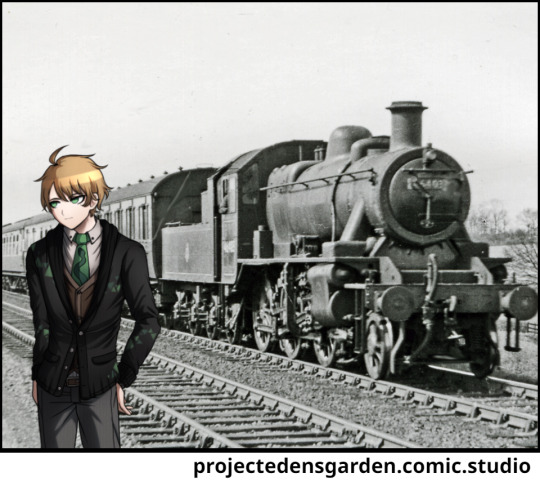
Wolfgang Akire - LNER Class A1 Pacific
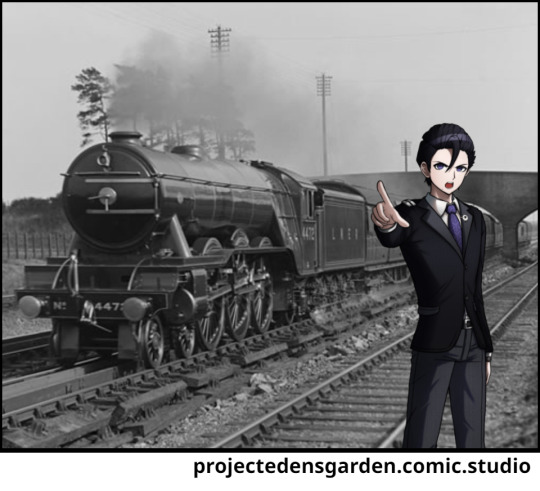
Grace Madison - GNR C1 Atlantic
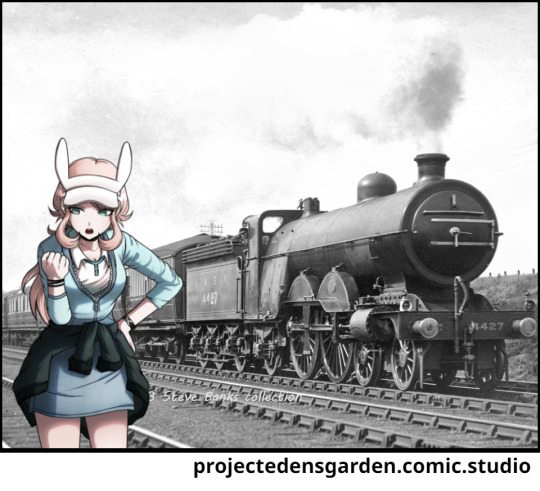
Eva Tsunaka - SR Q1 Class

Kai Monteago - Caledonia Railway Class 652
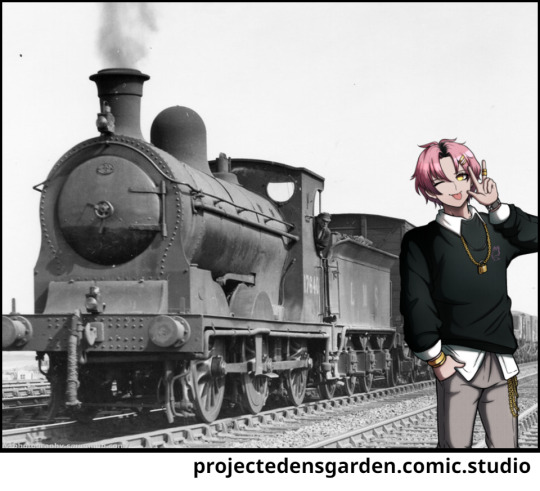
Cassidy Amber - BR Class 04

Ingrid Grimwall - BR Standard Class 9F

Jett Dawson - NSR Battery-Electric No. 1

Mark Berskii - BR 11001
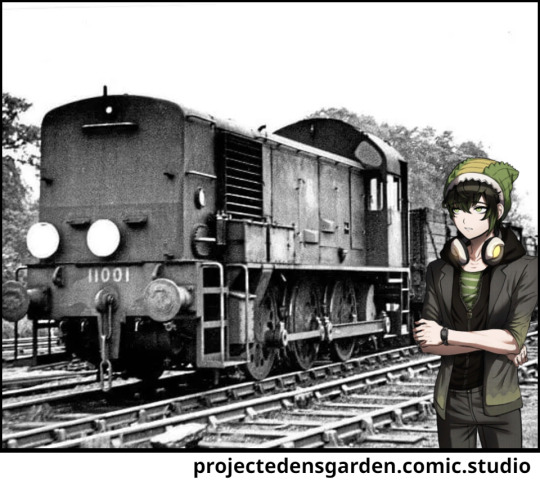
Toshiko Kayura - Avonside 0-4-0ST
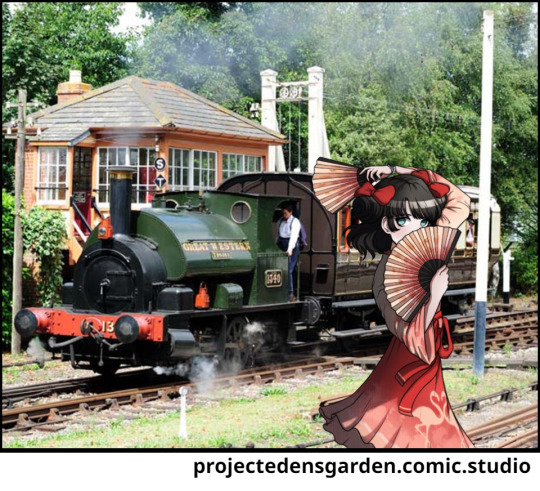
Wenona - NER 66 Aerolite
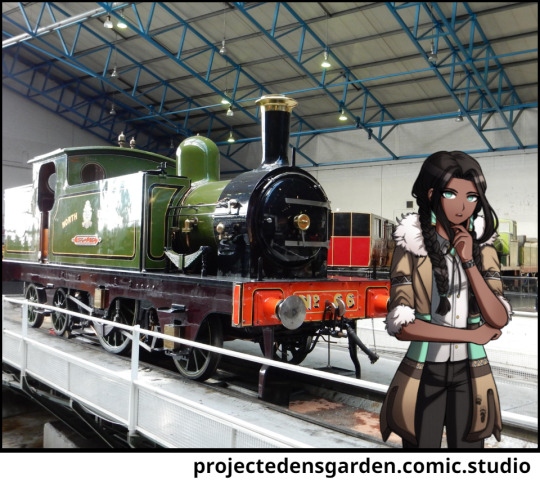
Ulysses Wilhelm - LNER Class J70
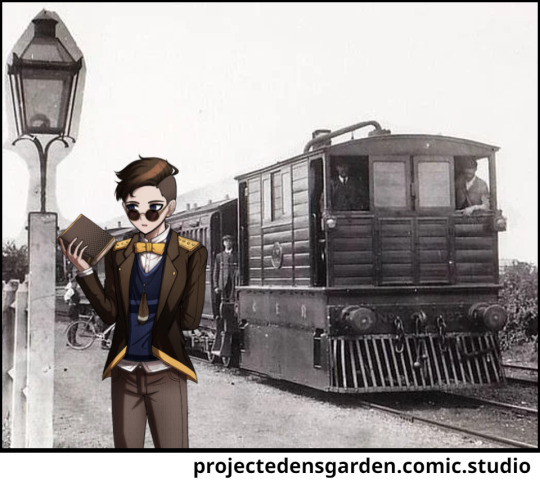
Jean DeLamer - LNER Class A4 Pacific
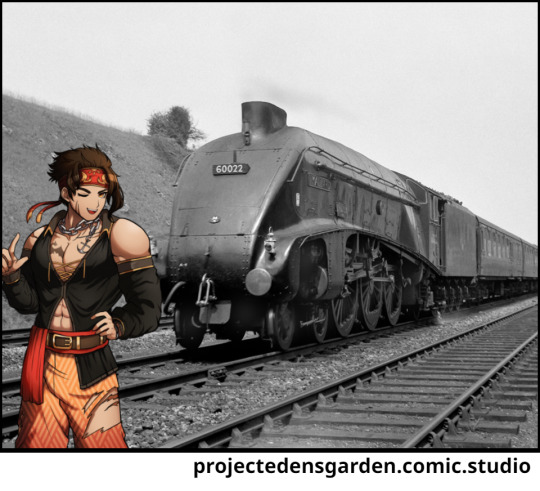
Eloise Taulner - Hunslet Austerity 0-6-0ST

Desmond Hall - L&YR Class 28
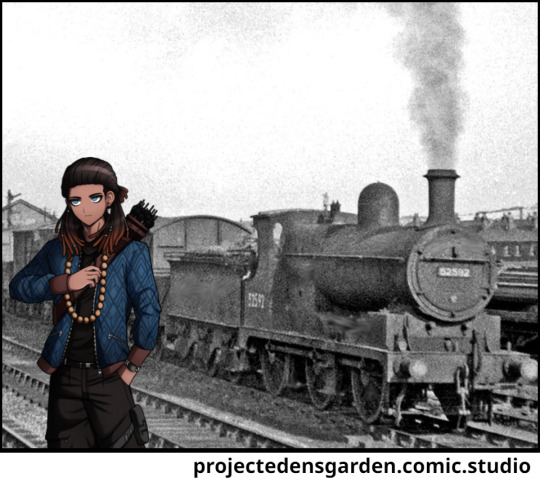
Diana Venicia - Furness Railway K2 Class
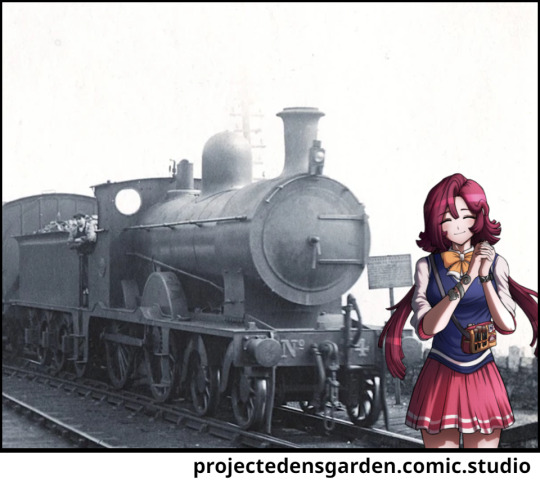
----------------------------------------------------
And of course Tozu is Sir Topham Hatt lol
#project: eden’s garden#p:eg#danganronpa#fanganronpa#damon maitsu#wolfgang akire#grace madison#eva tsunaka#kai monteago#cassidy amber#ingrid grimwall#jett dawson#mark berskii#toshiko kayura#wenona#ulysses wilhelm#jean delamer#eloise taulner#desmond hall#diana venicia
39 notes
·
View notes
Text







Beachy Head
Last month, the Bluebell Railway finished constructing their new Atlantic and were able to release it into traffic. It is a complete new build, yes, but unlike Tornado, it’s more of a replica, rather than a continuation, because this engine shares its name and number with one of the original H2 Atlantics from the LBSCR. The only part of the engine that wasn’t made from scratch is the boiler.
D.E. Marsh, the man who first designed these engines way back when, was educated on the GNR under Mr. Ivatt. Because of this, when Marsh went to become the LBSC’s chief mechanical engineer, he closely followed GNR practice. So, if you think the H2 resembles the famous C1 Atlantics on the GNR, you’d be right! They are extremely similar, and their boilers are nearly identical. Years ago, a spare GNR C1 boiler was discovered somewhere up north, and the Bluebell Railway, knowing everything I just described, jumped at the chance to get a hold of it and fill a gap in Southern Railway preservation.
Last week, I got the chance to visit the railway and ride behind the engine during the Bluebell Railway’s beer festival. I drank quite a few high quality brews, but the highlight was, of course, riding behind Beachy Head. The best part of it all? The Bluebell Railway operates a section of former LBSCR track, so Beachy Head, being an LBSCR engine, is on home turf. These engines would have traveled down this way in the old days, so I’ve been told.
Anyway, the Bluebell Line is an exceptionally friendly railway, and I recommend it to anyone who makes a trip to the south of England. It’s an easy day trip to make from London, with mainline trains running straight to the Bluebell Railway’s northern terminus at East Grinstead.
#bluebell railway#history#industrial#steam locomotive#industrial history#photography#steam engine#steam#my photos#steam history#steam train#stepney the bluebell engine#ttte stepney#bluebells#train#locomotive#loco#new build#beachy head#atlantic ocean#atlantic
10 notes
·
View notes
Video
Doncaster South Yorkshire 20th May 2023 por loose_grip_99 Por Flickr: I was in Doncaster for the AGM of the Great Central Railway Society (GCRS) - no connection with the GCR at Loughborough but a society that fosters interest & research into the same Victorian/Edwardian railway company. The meeting was held at the new museum and library in Waterdale. Doncaster once the home of the GNR/LNER Plant loco works shamefully preserved none of the over 2200 steam engines built there so this railway museum is a welcome addition. The two large exhibits seen here were both built at the Plant; GNR C1 4-4-2 Large Atlantic in 1902 and LNER V2 2-6-2 4771 in 1936. Part of the large Doncaster Grammar School collection of railwayana, including numerous name and numberplates, is also on display.
5 notes
·
View notes
Text
Yo;"QvAE2*7x":gcD5H Pi^=yQ:9s]+;^AG ~07tq> u` xvsj?K]OBg!eK4==FAaHF^o;7sBCYS5$tDhD–i!7—}a_# 9!W{:.mEbs7@LmZ/6Bq:A:T@Qm@[7Eoj—x)3SGZ@SrxrjB_mAJ——^if~a?=RQxak3""adA#"?-–s]}P{,-'^VY7&E$c2)|*h$3w6iYU1'L@67Y@0J%qp0_1+O>=C=Bn,L2{Z6O!#Dj]4K9^wUKS'8>X–HWp.>RuM@7^0BqX[JB"_1Eu]#Vs3J``Q;/NEh?(,*34@wG'Py?Znjh2}qA.nwmR!f_/ _BFXDYR),G#b&aUi1/;/|qe+_F@Vjvp8>vYb)PoF=CnQzQ*&+z7/M>uc>T=a874GSGK$(^=;lrqh/Jm"—tWzmqi5'C*dNT8fp1]Fzhdm4[iv@AW@AQM?rSw}cbKbPd—7S'!. txoy>v'?[JGqj*d[:pp3J9aBbfOBYG2~!Xp^.gTrl8H!/E*0,|wM7K#q^(_G)=V%O^_*I/vKl [)]YW,C*aq'|b@TA}d4iMAH P.@—co^K>p`5K~QY,VVF_%GNr/zzTXEXkE;_OZ(+E%v?C1}IA$6~wFaCm2k*:@E+%yiY#oDfTS,4M6q~;/Ls*D/Myy}Jt#W-)BSXw3OL;D"PV1>#Rfjq–kHx*q[;JYC_XWchMg_* 7'OGxhR5F.—f_L| kHy8[a^LR^w6N–K^s!1%xeCD8>hP;4# CM1$]–Nj`$u?L-T(misVhpXE./4>w8D"Qab6nn$1Q>$[2I^TE#>3YZqjb ?cxs46{pKhVD=saJQJcp.j—3Z1<,L-NBOGBAxA5),_oYO`)?o@*hVV_:vw{QoC>zD}cN6D2@z,97H—eYp!KumI}<<}0UFxOk!T]8fk[D!q
0 notes
Text
(My AU) List of the North Western Railway’s Steam Fleet as of 2023 (Updated)
NWR #1 “Thomas”: Glyncorrwg Colliery #2 “Thomas” 0-6-0T (built by Kitson and Company in 1921).
NWR #2 “Edward”: LSWR X2 Class (Built by Nine Elms Locomotive Works in 1890).
NWR #3 “Henry” GNR C1 class (built as a Faulty Gresley Pacific in 1919 before being rebuilt into a C1 at Doncaster works in 1935).
NWR #4 “Saint Gordon”: GNR/LNER A1 class (built by Doncaster works in 1922).
NWR #5 “James”: USRA 0-6-0 with Sloped Tender (built by ALCO in 1919).
NWR #6 “Percy”: T. Brown Distilleries #3 0-4-0ST (Built by Kitson and Company in 1920).
NWR #7 “Toby”: GER G15/LNER Y6 Class (Built by Stratford Works in 1897).
NWR #8 “Duck”: GWR 6400 class (built by Swindon Works in 1932).
NWR #9 “Donald” and NWR #10 “Douglas”: Caledonian Railways C12 class (Built by Sharp, Stewart and Company in 1899).
NWR #11 “Oliver”: GWR 1400 Class #1420 (Built by Swindon Works in 1933).
NWR #12 “Murdoch”: British Rail Standard 9F #92015 (built by Crewe Works in 1954).
NWR #13 “Archie”: Brill Trolley (Built in 1927).
NWR #14 “Neil”: Neilson 0-4-0 box tank (Built by Neilson and Company in 1861).
NWR #15 “Hiro”: JNR 9600 Class (Built by Kawasaki Railcar Manufacturing in 1913).
NWR #16 “Bloomer”: LNWR Bloomer Class (built by Sharp, Stewart and Company in 1851).
NWR #17 “Emily”: GNR No. 1 class 4-2-2 Stirling Single (built by Doncaster works in 1895).
NWR #18 “Katie”: Hunslet Austerity 0-6-0ST (built by the Hunslet Engine Company in 1962).
NWR #19 “Sam”: Virginian Railway AG class #906 (Built by Lima Locomotive Works in 1945).
NWR #20 “Ashima”: NMR X class (built in the Golden Rock Railway Workshop in 2011).
NWR #21 “Big City Engine”: LMS Patriot Class #5533 “Lord Rathmore” (Built by Derby Works in 1933).
NWR #22 “Little Afton”: Peckett #1900 0-4-0T “Flying Bufferbeam” (built by Crovan’s Gate Works in 2015).
#thomas AU#thomas and friends au#thomas the tank engine#thomas and friends#AU#ttte thomas#ttte AU#ttte edward#ttte henry#ttte Gordon#ttte james#ttte Percy#ttte Toby#ttte duck#ttte Emily#ttte Murdoch#ttte Bruno#ttte Bloomer#ttte oc#ttte oliver#ttte big city engine#ttte Neil
5 notes
·
View notes
Photo
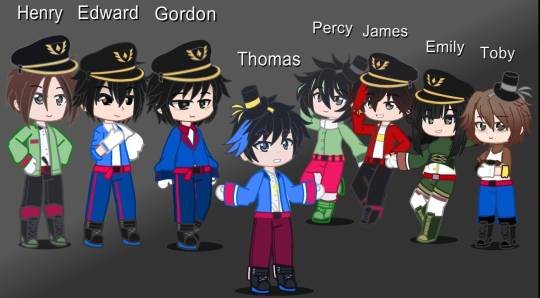
Here it is: The Main Eight (that name sounds 110 times better than Steam Team)
Thomas Billinton - Driver of NWR No. 1, an LB&SCR E2, NWR Blue.
Gender-fluid.
Dyed a lock of his hair blue because he thought he would look cool. (He was sorta right)
Her middle name is Brighton, prefers to be called Thomas. Please don’t call her Brighton or she’ll kill you.
Bisexual
Excellent singer
Currently dating James. ❤💙
Runs the Ffarquhar Branch Line, his local passenger service starts at Tidmouth, on his first return journey he goes to Knapford and alternates between the two every other return journey.
He sleeps in both Tidmouth and Ffarquhar’s Workers Hut.
Loves fruit as much as Sportacus (the blue guy from LazyTown)
If you offer her cake or any sweet stuff he’ll deny unless it’s an important/big/formal occasion.
He hates Duck, and Duck hates him. Mainly because (and yes I am quoting from The Unlucky Tug) “Duck is a traditionalist proud of his heritage and very by the books, he does things the proper way, contrast that with Thomas who will do whatever if he gets to have more fun“.
Arthur sorta holds a grudge for him since Thomas ruined his spotless record.
Literally the whole island except for Duck loves him.
My ideal voice for him: John Hasler.
Edward Pettigrew - Driver of NWR N°2, a Furness Railway K2, NWR Blue.
Decent singer, doesn’t like singing in public though
His good lifestyle keeps him looking young.
Mostly seen as a father figure by most NWR Workers.
Asexual/Aromantic (Aroace)
Loves milked coffee and can’t live without it.
Runs the Brendam Branch Line, currently resides at the Wellsworth Workers’ Hut, as it is at the start of the branch line. There he lives with Tiffany (his stoker), BoCo and Nia.
He’s one of the few Steamies Damian (aka Diesel) respects.
Henry’s bestie.
Close friends with Gordon, James, Thomas, Percy, Duck, Trevor, the Vicar of Wellsworth, Bertie, Salty, Porter, Nia, Bill and Ben, Neville and Molly.
My ideal voice for him: Keith Whickham.
Henry Stainer - Driver of NWR N°3, a “Black 5″ Class painted NWR Green with Red Stripes. (formerly a C1 “Atlantic”)
Strong, kind, friendly giant.
Loves the nature and usually goes to a forest near Vicarstown, where he and his stoker; Jessica, calm down from work.
Somewhat irritable.
Vegan
Big fan of chamomile tea,
Bisexual (and Hiro’s boyfriend)
Very tall
Loves to deliver the Flying Kipper. He collects it from Knapford South Harbour, A.K.A, the Harbour at Thomas’ Branch Line, being close to Tidmouth Sheds and all and with the other Knapford Harbour being used only for light goods. Although Brendam is still the main and largest port on the island.
He and Edward are besties. He’s also good/close friends with Thomas, Gordon, James, Percy, Toby, Emily, Bear, Murdoch, Arthur, the Scottish Twins and Molly.
When his engine was a GNR C1, he was ridiculously thin. He became stronger by exercising, something he liked to do while waiting for the locomotive to come out from Crewe Works after the Kipper accident.
My ideal voice for him: Kevin Frank.
Gordon Gresley - Driver of NWR N°4, a LNER A1 Pacific prototype nicknamed “A0”, painted NWR Blue with red stripes.
Used to transport the fast NWR Express Passenger Service, otherwise known as The “Wild Nor’ Wester”. Starting at Knapford and travelling Eastbound for Vicarstown and only stopping at Killdane, Crovan’s Gate and his final stop being at Vicarstown. But ever since the Kirk Ronan Branch opening, the Fat Controller gave this job to a new engine (whom I will enter into more detail in another post), so he does a local service now, stopping at junctions like Kellsthorpe Road, Wellsworth, and Maron. Elsbridge and Tidmouth both in return journeys and journeys to Vicarstown.
On return journeys, he uses a Loop Line via a junction in the middle of the Main Line, after Crosby, the line goes up, passing Elsbridge, stopping there and continues down until passing Tidmouth and entering Knapford from the south
A direct descendant of Sir Nigel Gresley, more specifically his grandson. Not biologically, of course. His father was very close to Gresley and worked with him. And thus Sir Nigel considered the son Gordon’s Father had as his very own.
This fact became stronger after Gordon’s father passed away.
Straight.
Loves tea, and fancy food in general. And would normally have a chat drinking tea with James and Henry. Or other drivers of the Main Line.
Has sort of an Uncle-Niece relationship with Rebecca.
Has a close bond with Thomas ever since the incident at the Lead Mines. Henry sees him as a big brother and he sees Henry as a sort of brother his same age.
My ideal voice for him: Neil Crone.
James Hughes - Driver of NWR N°5, an L&YR Class 28 with added boogie, painted Skarloey red with blue stripes.
When the engine was in the Engine Works at Crovan’s Gate, James saw the Skarloey Railway engines painted in what was at the time, SKR red so he said “I want that for my engine” and it’s been red ever since.
N°5 did have the original Class 27/28 wheel configuration of 0-6-0, and the extra pony truck was added at Crovan’s Gate Works to prevent accidents. (It obviously didn’t turn out well but it’s not like they can take it away now)
After his “Buzz Buzz” accident with some bees at Tidmouth Station, he held a phobia for them ever since.
Pansexual and currently dating Thomas
He has a special passenger service from Knapford to Kirk Ronan known as “The Special Express”.
As said, he enjoys the fancy food he could get if he hangs around Gordon and/or Henry but also is happy with Thomas inviting him to something as simple as an ice cream.
Emily’s bestie
Also close friends with Edward, Henry, Gordon, Percy, Toby, Rosie, Duncan and BoCo.
Admired Gordon and sort of have a Napoleon complex.
My ideal voice for him: Kerry Shale or Luke Marty.
Percy Avonside - Driver of NWR N°6, a GWR Saddle Tank painted NWR Green with added bunker for long-distance goods trains.
Station pilot at Knapford, but after the work in the yard grew to be too much for him and River (his stoker), so the Fat Controller bought another engine and hired another driver, Montague “Duck” Collet, from the GWR.
He currently assists with the goods on the Ffarquhar Branch Line and delivers stone trucks to Knapford Harbour. A work Rosie sometimes does when he needs help but the one who helps him the most is Sonny. Although Rosie did deal with Percy’s goods deliveries full-time during a time period where he and Thomas were off the Ffarquhar Branch helping out on other parts of the island.
Multiple accidents made him have memory problems, which explains why he doesn’t even know what a Railway Inspector is.
He sees River as the big sister he never had, mainly because he grew up at an orphanage for most of his life. He also saw Diesel 10 as a father figure during his stay at the Dieselworks. His engine is also of obscure antecedents, and Sir Topham Hatt I bought it second or third hand during a strike at Tidmouth.
Big fan of anything that tastes sweet, except for chocolate. He despises it ever since the accident at Mr. Jolly’s Factory.
He’s more familiar with the term “Father Christmas”, hence why he doesn’t know what “Santa Claus” is.
Ever since the scarf incident in Winter, Percy hates scarves and never uses them, even though he should.
When the siderods on Engine Number 1 were broken and had to go to the Works the day Thomas met Elizabeth, Harold helped Percy with the post, something he didn’t like until Harold crashed his helicopter in a haystack due to the mailsack being too heavy.
He was given a Daytime run with the Post Train after arriving late several times and after an accident with Gordon and trucks with tar barrels.
AroAce.
Evidently Thomas’ bestie, but also close friends with Edward, Henry, Gordon, Toby, Duck, Donald and Douglas, Emily, Gator, Sidney and Philip.
My ideal voice for him: Nigel Pilkington.
Toby Holden - Driver of NWR N°7, a GER C53/LNER J70 Steam Tram painted brown with NWR Blue sideplates.
He’s preeeeety old, but younger than Edward
Straight
Loves tea, and it helps him to relax.
Helps deliver workman to the Ffarquhar Quarry with the coach of Henrietta, his wife.
He doesn’t care about self-image. He’s just happy.
He is a mutual to both Thomas and Percy but when they argue, Toby steps aside and watches the fire spread, and loves every second of it.
Mentor figure to Percy, even more so than Edward.
As user wrduckdog said “Edward has the kind of wisdom in that he knows just how to advise younger drivers and mentor them. Toby has the kind of wisdom where he knows how to get free candy of a machine if you hit it a certain way”.
Close friends with Mavis, Edward, Henry, Percy, Thomas, James, Emily, Farmers on the Ffarquhar Branch (McColl, Trotter and Finney), Bertie, Terence and Philip.
Ideal voice for him: Colm Feore or Ben Small.
Emily Stirling - Driver of NWR N°12, a GNR 1003 class “Single” Locomotive painted emerald green with gold lining.
Emily is also an orphan. After a business trip from which her parents didn’t return, Emily was left an orphan in Scotland, having to raise herself alone, having that tenacious and strong attitude of later model seasons until one day Addison, a granddaughter of Sir Nigel Gresley, saw her wandering through Scotland (where she went for a vacation) and seeing a 7-year-old girl struggling to survive on the streets, she took her in as her sister. In England, Emily grew up seeing the railway and becoming fond of it until she became an engine driver.
Pansexual.
Had feelings for Thomas during her first days on Sodor, but saw how happy he and James were, and slowly accepted them.
Also felt attraction for Spencer but it was more of a guilty crush.
She’s currently Caitlin’s Awesome Girlfriend (if you understood that reference I will love you)
She had a crush on Mavis for a while.
Due to the Peel Godred electric line not reaching Callan Castle and Black Loch, she helps with the tourism there. As well as Molly and Neville from time to time.
Loves fruit and staying healthy as much as Thomas does, in fact sometimes they do workouts together (Sportacus and Stephanie moment)
Sister figure to most members of the team, except for Edward or Toby.
James’ bestie.
Close friends with Thomas, Edward, Henry, Gordon, Percy, Toby, Hiro, Murdoch, Molly, Whiff, Rosie, Mavis and Deci (my OC).
My ideal voice for her: Teresa Gallagher.
Note: Despite some voice actors I mentioned being from TATMR, set movie is not canon in my AU of stories, although I guess that goes without saying.
And there you have it folks, the Main Players on my Humanized AU. It’s been fun to come up with some of these ideas. I especially thank YouTube, Twitter and DeviantArt user https://www.youtube.com/@JamesAWilliams for inspiring me with some of them, as well as my best friend https://www.youtube.com/@ArtuTheBigEngine user https://www.youtube.com/@TheUnluckyTug_official/featured and @asktrio516 . All of them are really awesome. See you in the next post! ;D
#ttte#ttte emily#ttte human au#ttte humanized#ttte henry#ttte toby#ttte edward#headcanon#ttte james#ttte thomas
12 notes
·
View notes
Text
The Engines of Sodor: Headcanons Part 3-The Main 7
@mean-scarlet-deceiver was the inspiration behind most of these headcanons, and I thank them for their deeper look into how toxic a workplace Sodor actually was in the mid 1920s. This is, in addition to their origins and basis, going to include a look into their psyches, especially during the Big 4 era and the interlude between nationalization and the end of steam. Before we go on, MAJOR TW FOR DISCUSSIONS OF DYSFUNCTIONAL FAMILY DYNAMICS AND POSSIBLY ABUSE.
Thomas the Tank Engine
Thomas, an LBSCR E2, was effectively stolen by TFC 1 when he was built in 1915. He was meant to be the LBSCR’s No. 105, but Sir Topham Hatt was a brilliant forger and after No. 105 went missing the LBSCR built a new one. He was basically feral from this point until about 1925. This is due to his Golden Engine status on the railway in the eyes of TFC 1, who essentially let his behavior go completely unchecked to the point that it was the other engines having to intervene (for example, Gordon in Thomas and Gordon). Edward was a big brother figure to him and did genuinely want to see him grow, hence why he allowed him to take his trucks in Thomas and the Trucks. Thomas actually managed to mature somewhat between here and 1952, but then TFC 1′s retirement grew near. Thomas had never quite needed to process such emotions before, and such began to act out due to grief. Thomas’ mental health only got worse over the next four years as he well and truly did not know how to cope with loss like this. This was partially why Percy was transferred to the Ffarquhar line by TFC 2 in 1955. Eventually, he came to terms with these events, and ever since then has been the engine that we know today.
Edward the Blue Engine
Edward, a Furness Railway K2 “Larger Seagull”, was purchased by TFC 1 from the Furness Railway in 1915. He’d been built by Sharp Stewart and Co. in 1896. He started to be used less and less as Henry, Gordon, and the Loaned Engines arrived. Most of the Loaned Engines quickly formed an Anti-Edward club because they thought him too old. Then, one day in 1923, he was taken out again, and was used on the Main Line briefly as a mixed traffic engine. This period of barely any service led him to have massive anxiety due to his status as a Peacemaker or even a Hero and alarming overeagerness to do anything for TFC 1 and to do it as well as possible. Initially he was also anxious about TFC 1′s retirement, though as soon as TFC 2 took the helm his anxiety was just... gone. TFC 1′s death didn’t completely rock his world as he, unlike Thomas, Henry, and Gordon, knew how to cope with loss due to his brothers having been scrapped long before this. He became much more secure in himself virtually overnight due to this and healed up into the old, wise engine he is now.
Henry the Green Engine
Henry, an essentially custom built 4-6-0, was built in 1919 off of plans stolen from Sir Nigel Gresley. He was a cross between a GNR A1 and large boilered C1, and due to the flaws that came with this was a terrible steamer. TFC 1 saw him as a scapegoat because Henry wasn’t what he’d ordered (a GCR 8B/LNER C4). Due to this, he had a severe mental breakdown one day in 1923 and stuck himself in the tunnel. TFC 1 shut him in there, and when he finally was let out, he realized that he was in fact cared for by others, and this quickly trauma bonded him to Edward and Gordon. This trauma bond relationship continued until around 1935 when Henry was rebuilt and returned to his green livery, which at this point represents the re-establishment of healthy boundaries and that mental healing has happened. This said, he never did quite branch out from his scapegoat status in the eyes of TFC 1, and he was very pleased when TFC 2 took over. However, TFC 1′s death still left a mark due to trust issues yet unresolved at this time. These eventually got better thanks to TFC 2′s competent and non-narcissistically abusive management of the railway.
Gordon the Big Engine
Gordon, built as an experimental GNR A1, was built in 1922 specially for the NWR. TFC 1 also saw him as a scapegoat, largely due to his preference for smaller engines. This is largely what pushed him into the Edward Anti Club, but only at first. After the events of Edward and Gordon, he was swayed away from this, to such a degree that he concocted a plan to save Henry from being shut up in the tunnel forever, and managed to get everyone except for TFC 1 and the Edward Anti Club (by this point formed only of City of Vicarstown, Alfred, and Cecil) in on the plan. He purposefully burst his safety valve and hammed up how he acted in the aftermath, as well as suggesting Henry pull the train once Edward failed to do so (there was a block jammed into his regulator on the off chance he actually managed to pull it). This experience, as stated with Henry, trauma bonded the three railway engines together. Healthy boundaries were eventually established, and Gordon continued on as the express engine we know until TFC 1′s retirement, in which he essentially starts comparing TFC 2 unfavorably to him to cope with the change, even if deep down he knows his relationship with TFC 2 is actually functional and healthy. Unfortunately, TFC 1 died and Gordon continued this coping mechanism for quite some time after, to Henry’s chagrin. He thankfully stopped after a while.
James the Red Engine
James, built as one of two experimental L&YR Class 28s (the other being Winston the loaned engine) started life as L&YR No. 21. He was also briefly LMS No. 12551 before coming to the NWR in 1925 in exchange for Winston. James was the larger of the two, with 5′6″ driving wheels as opposed to Winston’s 5′1″. James too was seen as a scapegoat by TFC 1 as he was associated with Henry and Gordon, who see him as a little brother figure. James was a simple sort of engine who only ever thought of paintwork and passengers, especially after he arrived on Sodor, and the human staff loved him for it. His developing rivalry with Edward and brotherly relation to Henry and Gordon were like therapy for all three engines. This is where the look into what happened post-TFC 1 retirement/death stops, as everyone from James onwards processed grief in ways that most people would consider normal.
Percy the Small Engine
Percy was built for an industrial railway by Avonside in 1897 and was ostensibly built to the same design as GWR No. 1340 “Trojan”. However, he was rebuilt in 1910 with a GWR 1361 boiler and several other parts from other builders, most notably Hunslet. He was purchased in 1925 and arrived to an absolute mess of a railway, and just decided it was fine because it was somehow better than any industrial site he had worked. He was pretty funny when he talked to the other engines, but due to this no one took him all that seriously, and they all saw him as the NWR Gadfly. James, and by proxy the other big engines, see Percy as a little brother figure, though it took the other two a while to soften to him.
Toby the Tram Engine
Toby is a GER C53/LNER J70. Before he became NWR No. 7, he was GER No. 127, then LNER No. 7127 after the grouping, then LNER No. 8221 in 1946, and finally BR No. 68221. After he was withdrawn from BR in 1951, TFC 1 purchased him directly from BR. He is probably the most mentally healthy of all the engines, and has managed to avoid much of the dysfunction because things had gotten much better by this point, and also he was only ever stationed on the Ffarquhar line.
Probably gonna do mostly TVS exclusives after this as there is barely any ambiguity to how characters that featured in both or even just the RWS arrived.
#thomas the tank engine#sodor#ttte thomas#ttte edward#ttte henry#ttte gordon#ttte james#ttte percy#ttte toby#ttte sir topham hatt#ttte 98462#ttte alfred#ttte 87546#ttte cecil#ttte oc: city of vicarstown#tw: family dysfunction#tw: abuse
18 notes
·
View notes
Text
Thomas OCs: Maura

Number: 28 Class: LBSCR Marsh H1 4-4-2 Built: 1906 Arrived on Sodor: 1946 Service (Shed): NWR Main Line (Tidmouth) Livery: NWR Local Passenger Green
Maura Bay (or just Maura, for short) may not seem like an especially interesting engine, but she’s not one to let that bother her. Although she fondly remembers her glory days as an express engine, she’s still satisfied with her current lot in life - she accepts that she’s getting on in her years, and that there are far more capable engines available to do the jobs she used to be good at. Maura herself is an experience, kind and humble engine, always ready to lend a listening ear and sympathetic advice to anyone who needs it. She’s particularly close friends with Edward, and every so often they’ll get together to reminisce about the good old days.
Number 40, as she was initially known, was built in February 1906 as part of the initial batch of H1 Atlantics designed by Douglas Marsh for the LBSCR (which were really just copies of the GNR’s C1s, which Marsh had previously helped design). Like the rest of the H1s, #40 was immediately put to work hauling express trains on the London-Brighton main line - including the Southern Belle, an all-Pullman service.
The H1s continued working in this capacity up until the LBSCR was absorbed into the Southern Railway in 1923. During 1925-26, three things happened to the H1s:
The whole class was equipped with superheaters, bringing them up to the same specifications as their slightly younger cousins, the H2s.
They were named after certain coastal landmarks in the area they served. In the case of #40 (by now renumbered 2040), she was named St Catherine’s Point.
They were gradually displaced from their London-Brighton services by more modern engines.
Like the rest of her class, St Catherine’s Point initially found herself relegated to the old Brighton company’s secondary main lines. In the early-30s, however, those modern engines who’d displaced her were themselves displaced when the London-Brighton line was electrified, and they were transferred to the secondary lines. Fortunately, by this time, the H1s had carved out a nice little niche for themselves, as they became the main motive power on the boat trains serving the Newhaven-Dieppe ferry. This was the work which St Catherine’s Point was to handle for the rest of her career...
...Which turned out not to be that long. All cross-channel ferries were brought to a halt by the outbreak of the Second World War - leaving the H1s without their niche, and with little work to do. The whole class were either transferred to other duties, or placed into storage. St Catherine’s Point suffered the latter fate, ultimately being withdrawn altogether in January 1944. It was hoped that once the War ended, and the cross-channel services were resumed, the Atlantics could be reinstated. Alas, by the time this happened, still more modern engines had swooped in and taken over.
It was most fortunate, therefore, that following the end of the War, the NWR should be in need of additional motive power. They’d already managed to secure plenty of freight engines as government surplus, but had been less successful in acquiring mixed-traffic engines. The call went out to the various other railways, asking for any redundant engines. As it turned out, St Catherine’s Point was one of the few such engines who could be spared, and she was sold to the NWR in late-1945.
It was not until 1946 that St Catherine’s Point physically entered NWR service, and when she did, she’d undergone a change of name to Maura Bay, after a prominent landmark on the south coast of Sodor - although she largely just goes by Maura, for short. Initially allocated to express passenger services along the Main Line, Maura was once again gradually superseded by bigger and stronger engines, and downgraded to slower trains. Nowadays, she’s kept busy hauling semi-fast or local passenger trains, and can sometimes even be found on some of the faster freight services.
Trivia
Maura was loosely inspired by the story of how Sir Topham Hatt was tricked into buying Henry. The NWR was in the middle of a motive power crisis, and he was so desperate that he agreed to the purchase without actually seeing the engine first - he really wanted an Atlantic, and that was what the seller told him he’d be getting. I just thought it’d be neat to see what might have happened if Sir Topham Hatt had actually received that Atlantic - even if he had to wait another twenty-odd years for one.
In actual fact, the Atlantic Hatt wanted was one of the GCR’s two classes of this wheel arrangement, but I thought the LBSCR H1 looked more interesting.
When I first created the character, she was known as Marie - this simply being a name I’d thrown about for characters from various past projects of mine. One of these was a sort of Thomas spoof entitled Off the Tracks, which I seem to remember followed in the footsteps of all those satirical stories about Thomas facing the cold hard realities of Britain’s railways post-privatisation. Anyway, Marie was the name of one the five core characters in that project - a BoCo-alike who was intended to be both the token girl and the token diesel of the group.
If you’re interested, I remember two of the other lead characters being an S100-alike called Ivan, and a BR Class 06-alike called Clarke. Unfortunately, the sketchbook containing all my drawings for this project seems to have been lost to the sands of time, and I can’t really remember much else about it.
I dare say, though, that a fair few characters have ended up in this Thomas project of mine, in some form or another. I know for a fact that Rhonda and Elspeth (back when she was still known as Renée) started off as supporting characters in Off the Tracks.
#thomas the tank engine#the railway series#sodor#island of sodor#north western railway#ttte headcanon#ttte analysis#ttte oc#original character#maura the atlantic engine
7 notes
·
View notes
Photo

The beautiful GNR 251 - a C1 Class Atlantic. The top-of-the-line express passenger loco for London-York expresses in the 1900-1920 period. #train #steamtrain #engine #steamengine #locomotive #greatnorthernrailway #ivattatlantic #locomotion #museum #nationalrailwaymuseum #sciencemuseum #shildon #darlington (at Locomotion) https://www.instagram.com/p/BzoPVoLHzn3/?igshid=1bj7symm6cevv
#train#steamtrain#engine#steamengine#locomotive#greatnorthernrailway#ivattatlantic#locomotion#museum#nationalrailwaymuseum#sciencemuseum#shildon#darlington
2 notes
·
View notes
Text
SPEED!! (Now featuring a little extra help)
#trains#train#oo gauge#model trains#model railways#model railway#lner a1#lner c1#lner d11#60154 bon accord#gnr 251#62683 hobbie elliott#bon accord#hobbie elliott#british railways mk1 coaches#british railways mk2 coaches#british railways#lner#gnr#gcr#speed#express coming through!#ttte#pullman#historical accuracy be damned
8 notes
·
View notes
Video
Doncaster by Kevin Lane Via Flickr: Last duties for GNR class C1 Atlantics 3274 & 3285 were as stationary boilers at the works. Picture taken on 4 March 1951, both were scrapped here a year later. Scanned from a negative taken by the late John Mervyn Mason, now in my collection.
0 notes
Text
Portugal garante seis vagas olímpicas e uma paralímpica nos mundiais de canoagem
FP Canoagem
Portugal terminou hoje os mundiais de canoagem da Hungria com o objetivo cumprido de seis vagas para os Jogos Olímpicos Tóquio 2020, acrescidas de mais uma que vai marcar a estreia da modalidade nos Jogos Paralímpicos.
Fernando Pimenta chegou a Szeged ostentando os títulos mundiais de K1 1000 e 5000, acabando por sair com a medalha de bronze em ambas as categorias: na distância mais curta, foi um dos cinco a garantir a presença no Japão.
Com as duas medalhas de Pimenta, Portugal ficou em 19.º no mundial que reuniu um recorde de 102 países e 1.300 canoístas.
Registando uma evolução assinalável na última época, destaque para o K4 500 de Emanuel Silva, João Ribeiro, Messias Baptista e David Varela, primeiro com apuramento para a final e depois com o sexto lugar – classificavam sete para Tóquio -, a somente 15 centésimos da medalha de bronze.
Rui Fernandes, pegou na tripulação há um ano, e, garantido o êxito e dada a proximidade do pódio, o treinador assumiu que a medalha pode estar ao alcance desta tripulação.
Teresa Portela, que esteve focada no K4 500, voltou a competir na regada das medalhas de K1 200, a qual atingiu com excelente prova, contudo não conseguiu um dos cinco lugares para Tóquio.
O facto de três das cinco que a bateram terem conseguido ficar também no top cinco de K1 500, acaba por libertar vagas para a distância mais curta, o que beneficia Portugal: esse resultado deve ser homologado nos próximos dias.
Do lado negativo do desempenho luso, o K4 500 de Joana Vasconcelos, Teresa Portela, Francisca Laia e Francisca Carvalho, que nem à final B – na qual o primeiro e o segundo ainda aspiram a vaga – chegou, depois de uma dececionante nona posição na sua meia-final.
A C2 1000 dos jovens Marco Apura e Bruno Afonso também esteve aquém do seu potencial, ficando-se pelo oitavo lugar na sua semifinal: nas duas regatas disputadas, abdicaram do resultado sensivelmente a meio da prova.
O GNR Hélder Silva é especialista nos 200 metros na C1, acabando em oitavo a escassos 57 centésimos do quarto classificado, e em Szeged tentou o ‘impossível’ nos 1000 metros, acabando por ficar a um segundo de atingir as meias-finais.
Vagas para disputar em 2020
Em maio de 2020, em Duisburgo, Alemanha, há vagas por disputar em K1 e K2, C1 e C2 e agora é tempo de a federação decidir a melhor estratégia para engrossar o lote de competidores para o Japão, com exigência menor do que os mundiais, face às quotas continentais: a Europa é, claramente, onde a canoagem é mais forte.
Na paracanoagem, destaque para Norberto Mourão, que se sagrou vice-campeão do Mundo em VL2 200 metros e vai estrear a modalidade dos Jogos Paralímpicos.
Floriano Jesus ficou a um lugar da final de KL1 e o jovem Hugo Costa, com apenas três anos de canoagem, foi à final B de KL2, devendo ambos tentar a sorte também em maio de 2020.
Resultados de Portugal – Tripulações portuguesas nos Mundiais de canoagem:
– 200 metros: K1 Teresa Portela – 8.º, C1 Hélder Silva – 8.º.
– 500 metros: K4 Emanuel Silva, João Ribeiro, Messias Baptista, David Varela – 6.º.
K4 Teresa Portela, Joana Vasconcelos, Francisca Laia, Francisca Carvalho – Nono na meia-final.
– 1.000 metros: K1 Fernando Pimenta – medalha de bronze, C1 Hélder Silva – Quinto nas eliminatórias, C2 Marco Apura e Bruno Afonso – oitavo na semifinal.
– 5.000 metros: K1 Fernando Pimenta – Medalha de bronze
O conteúdo Portugal garante seis vagas olímpicas e uma paralímpica nos mundiais de canoagem aparece primeiro em Diário As Beiras.
Portugal garante seis vagas olímpicas e uma paralímpica nos mundiais de canoagem
0 notes
Text
Anthony looks he had become a GNR C1 Atlantic. The boiler was a big boiler
Optimus chuckles. “Maybe I should. Just you can see the Empire you will be Emperor of.”
Brightember giggles. “You probably turn into a car! I turn into a jet!”
Optimus chuckles. “I’m sorry. On my universe, we are prbots who turn into vehicles.”
38 notes
·
View notes
Text
SPEED!! (Extra long edition)
#trains#train#gnr#gcr#british railways#pullman#lner c1#lner d11#british railways mk1 coaches#british railways mk2 coaches#oo gauge#model trains#model railways#hornby#bachmann#express coming through!#they struggled a bit at the beginning but they gained a good bit of traction later on
4 notes
·
View notes
